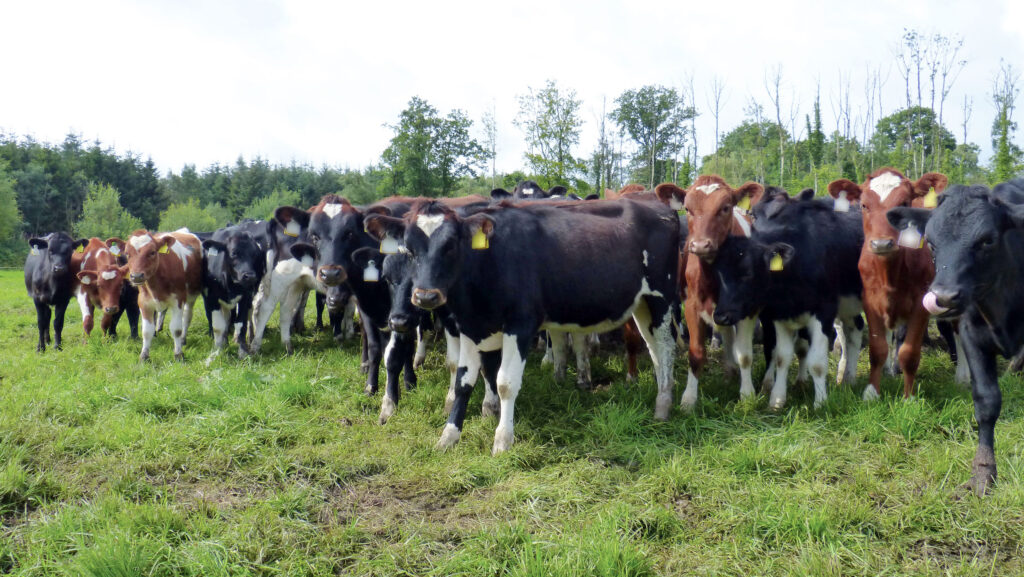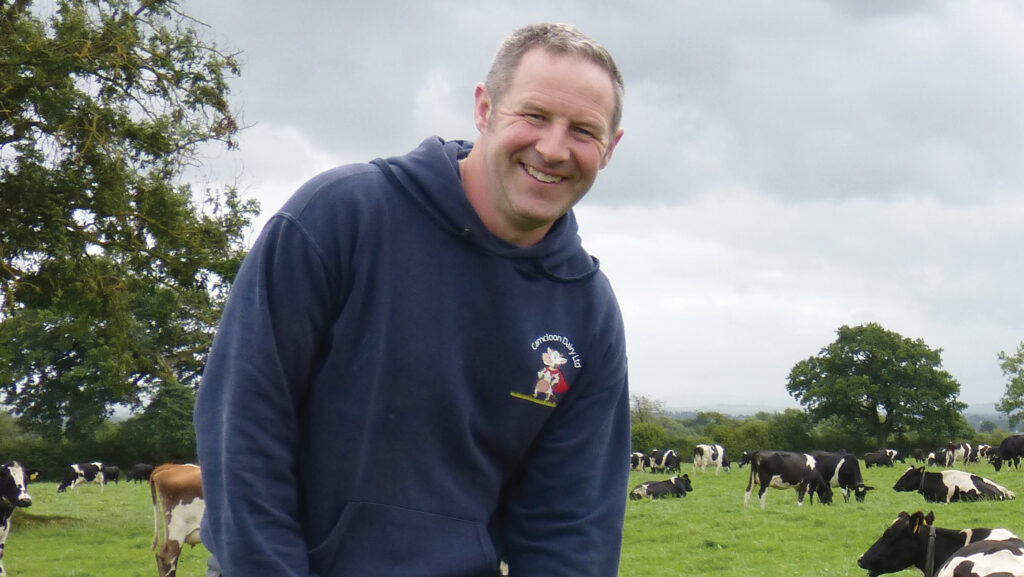Beetle-friendly parasite policy saves £8 a cow for dairy farmer
 © MAG/Michael Priestley
© MAG/Michael Priestley An environmentally conscious dairy farmer has cut youngstock treatments by 70% thanks to a pioneering multi-pronged approach to parasite management including dung beetles.
Spring block-calver Bruce Thompson at Camcloon Dairy, near Portlaoise, County Laois, has saved more than £2,500 across his R1 and R2 heifers and milking cows by working with nature to cut anthelmintic treatments and pyrethroid applications.
“My view is wormers are helpful – I don’t want to lose them,” says Bruce. “I want to make sure they keep working by not overusing them and selecting for resistance.
“Furthermore, anthelmintics have a negative, unintended effect in that they are broad-spectrum. In many cases we are unintentionally killing insects that would have benefited us.”
See also: How regenerative farming can improve livestock health
Farm Facts
Camcloon Dairy, County Laois
- 270 spring-calving milking cows
- Jersey cross Friesian herd
- 101ha grazing platform
- 44ha support ground
- 68ha owned, rest is leased
- Supplying manufacturing milk to Tirlan
- Averaging 471kg of milk solids a cow
- 1,100-1,200mm of rainfall/year on medium to heavy clay loams

Bruce Thompson © Michael Priestley
Techniques
A 2020 Nuffield scholarship was the catalyst for the on-farm change. Bruce travelled to Tasmania, Australia and around the UK and Ireland to study sustainable wormer use.
He has combined a range of methods learned through study and travel to reduce the need to treat animals for worms and flies, as follows:
Targeted selective treatments
Instead of treating a whole mob of R1s for worms, Bruce treats only those with low growth rates or loose dung.
This typically means R2s and milking cows can go without wormers as they have built up immunity.
Reduced anthelmintics use slows down the rate at which resistance develops and means fewer helpful insects (like dung beetles) are killed by these broad-spectrum drugs.
Treating affected animals only, and killing the parasites in those animals, can help clean an infected pasture because the life cycle (which can take three weeks) is broken.
Faecal egg counts
Bruce has his own microscope for carrying out faecal egg counts (FECs) through the spring and summer on his R1s. The trigger number for treating is typically 250 eggs per gram.
Beetles
When fresh, a cow pat is a moist haven for flies, worms and fluke to complete their lifecycles. Dung beetles drink the liquid in the pat, living off the microbes.
They also bury balls of dung for incorporation deeper into the soil by worms and other insects. A pat that has been sucked dry by beetles cannot support worm eggs, breaking the parasite life cycle.
Bruce is collecting beetles and placing them in enclosures in overgrown habitat areas to breed.
Clean grazing
Bruce ranks pasture parasite risk on a traffic light system:
- Green (low risk) An arable field reverted to livestock or one that has been through the spelling process (see below) or grazed by animals that have just been treated with wormer
- Amber (medium risk) Pasture infected by shedding calves that has been recently grazed by cows or R2s to “hoover up” some parasites
- Red (high risk) Pasture that has been grazed most recently by R1 calves that were noticeably shedding eggs.
Spelling pasture
A process by which an infected “red” pasture can be turned into a clean pasture by:
- Silaging Cutting for silage physically removes parasites and lets ultraviolet light and air into the sward base. This kills infective stage larvae through the acidification process of ensilement and means parasites dessicate in the sward.
- Cow hoovering Cows and R2s then graze the field two or three times before it is closed up for winter. Parasites are hoovered up by the older cattle and die in their rumens. On-off grazing for two to three hours limits the number of fresh pats put on the field.
Eucalyptus oil
This is used in two ways:
- R2 pour-on Applied on R2 heifers’ backs (20-30ml) in summer when flies are problematic – used twice in 2023, but not used this summer
- Teat spray Emulsified with polysorbate and water and included in the cow’s teat spray at 1% inclusion – not needed this summer.
Stockholm tar
Very sticky tar is applied with a decorator’s paintbrush to cow and heifer teats to deter flies. This has not been required this year.
Youngstock protocol
As the most susceptible animals on the farm, calves are a focal point, explains Bruce. He has devised a system to build up calf parasite immunity, while being labour efficient.
Calving starts on 1 February. Newborn calves are given colostrum at 8.5% of birthweight (average is 25kg) followed by dam transition milk.
They are placed in a wheelbarrow and genotyped, registered, ear tagged, and their navels treated with iodine, before being weighed (by subtraction) by walking the barrow onto a wooden frame with a built-in weigher.
They are fed individually for one to three days, then placed in groups of 20. When weather allows, they are turned outside onto a green-risk-level pasture, with 60 heifer calves eventually on one milk feeder.
Calves strip graze on two- to three-day moves with pelleted calf feed fed through a restricted feeder.
Milk replacer is prepared by a paddle mixer, which is gravity fed by a water heater. Milk is supplied at 39C through a mobile milk pumping station.
Calves are initially given more lignified covers of 3,500kg dry matter/ha or more to develop their rumens. Limiting the rich spring grass also reduces scours.
Calves are weighed every four weeks and FECs are taken if Bruce suspects parasite challenge may be developing.
Daily liveweight gains must average 0.6kg for them to hit a 300kg bulling weight by 1 May and grow into a 480-500kg mature cow.
Calves are weaned at 2.7 times their birthweight. When they reach 160kg or more in August, they are introduced to amber pasture to develop tolerance.
Their first winter is spent on a slatted shed from mid-November until March/April turnout. Animals are grouped on weight, so smaller animals can have their silage supplemented with 2kg of concentrate/day.
Once turned out as R2s, the animals should have immunity, so can be used as hoovers in the spelling process.
Savings
Bruce has recorded as few as one lungworm treatment and 0.7 worm treatments on average on R1s, down from four treatments a calf in 2020.
This is saving time, effort and money, while reducing parasite resistance, he adds.
Parasite control costs: 2019 and 2023 compared |
|
|
Conventional approach 2019
|
Targeted, selective beetle-friendly approach 2023
|
|
75 calves (0-12 months) received two white drenches and three pour-on wormers for flies and lice. Cost £218.39 75 in-calf heifers (12-24 months) received two clear pour-on wormers and one fly control product to control stomach worms, flies and lice. Cost £433.35 270 lactating cows received one clear white wormer mid-season, one dry-off dose of white drench and one mid-season fly control product. Cost £2,250.90 Total cost £2,902.74 |
75 calves (0-12 months): About 60% of calves were wormed for stomach worms on four occasions, alternating between white and yellow drenches. Cost £84.75 75 in-calf heifers required four buckets of Stockholm tar and four litres of eucalyptus oil. Cost £308.32 270 lactating cows used 10 litres of eucalyptus oil. Cost £342.57 Total cost £735.64 Total saving £2,167.01 or £8.02 a cow
|
